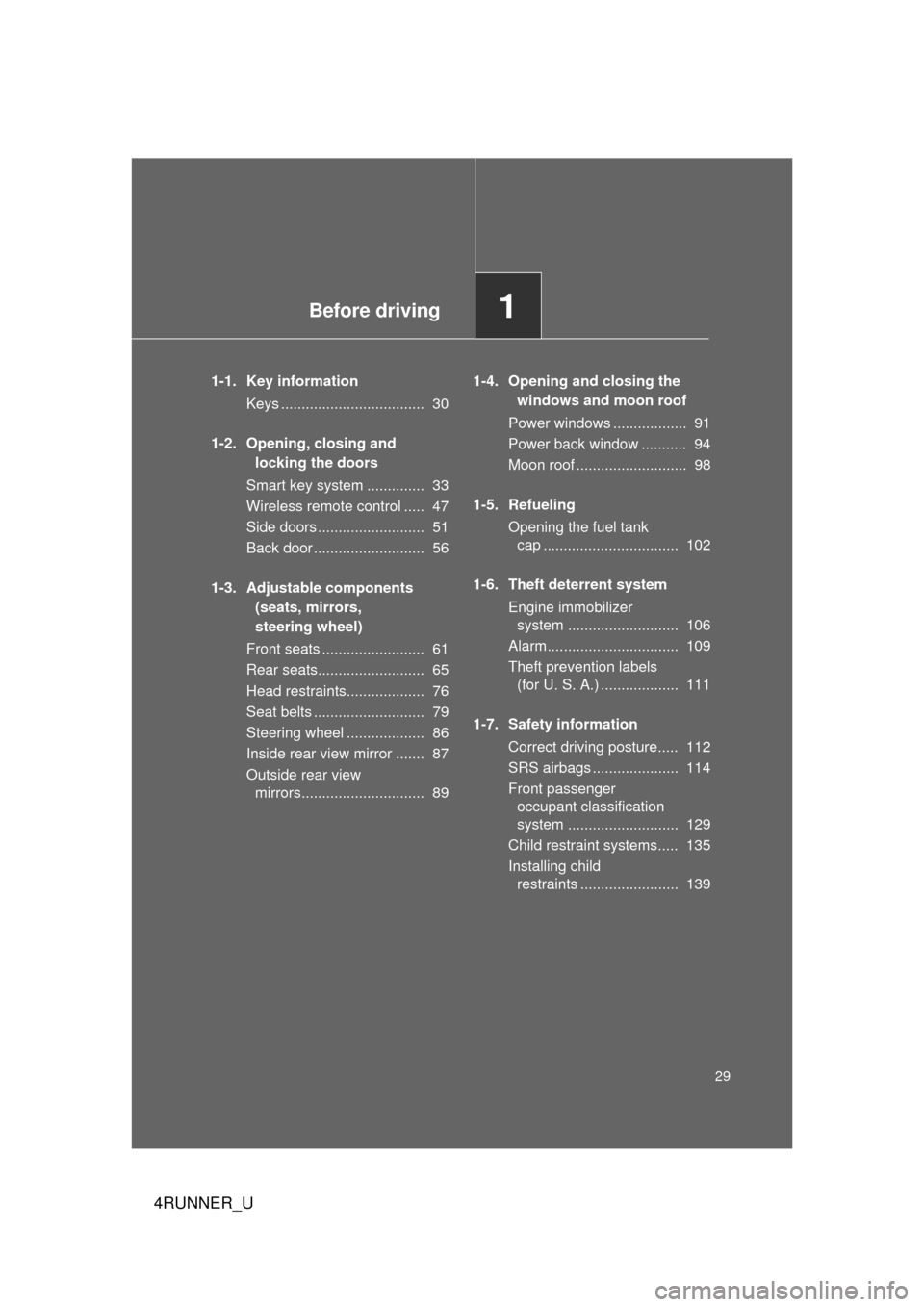Page 2 of 665

TABLE OF CONTENTSIndex
4RUNNER_U
2
1-1. Key informationKeys ..................................... 30
1-2. Opening, closing and locking the doors
Smart key system................. 33
Wireless remote control ....... 47
Side doors ............................ 51
Back door ............................. 56
1-3. Adjustable components (seats, mirrors,
steering wheel)
Front seats ........................... 61
Rear seats ............................ 65
Head restraints ..................... 76
Seat belts ............................. 79
Steering wheel ..................... 86
Inside rear view mirror.......... 87
Outside rear view mirrors ..... 89
1-4. Opening and closing the windows and moon roof
Power windows .................... 91
Power back window ............. 94
Moon roof ............................. 98
1-5. Refueling Opening the fuel tank cap ................................... 102 1-6. Theft deterrent system
Engine immobilizer system .............................. 106
Alarm .................................. 109
Theft prevention labels (for U. S. A.) ..................... 111
1-7. Safety information Correct driving posture ....... 112
SRS airbags ....................... 114
Front passenger occupant classification system ......... 129
Child restraint systems ....... 135
Installing child restraints ..... 139
2-1. Driving procedures Driving the vehicle .............. 154
Engine (ignition) switch (vehicles without a
smart key system) ............ 164
Engine (ignition) switch (vehicles with a smart
key system) ...................... 167
Automatic transmission ...... 173
Turn signal lever ................. 179
Parking brake ..................... 180
Horn .................................... 181
1Before driving
2When driving
Page 10 of 665
4RUNNER_U
10
CTHPIAS047
Pictorial indexInterior
SRS front
passenger
airbag
P. 114
SRS driver airbag P. 114
Head restraints P. 76
Front seats P. 61
Rear seats P. 65
Console box
Tissue pocket Pen holder P. 418
P. 420
P. 421
Seat belts P. 79
Cup holders P. 423
Armrest P. 448
Cup holders P. 423
Glove box
P. 417
Floor mats
P. 449
Power window switches P. 91
SRS knee airbags
P. 114
SRS side airbags P. 114
Rear seats P. 65
Bottle holders
P. 427
Page 11 of 665
4RUNNER_U
11
CTHPIAS006
Inside rear view mirror P. 87
SRS curtain shield airbags P. 114
Interior light P. 414
A
Personal lights Interior light P. 414
P. 414
: If equipped
Sun visors P. 429
Garage door opener switches “SOS” button
Moon roof switches
Active traction control switch
VSC off switch
Rear differential lock switch
Downhill assist control switch
P. 462
P. 469
P. 98
P. 230
P. 232
P. 235
P. 238
Auxiliary box
Crawl Control switch
Multi-terrain Select switch
P. 422
P. 241
P. 245
Vanity mirrors P. 430
Rear view monitor system P. 218
Page 25 of 665

4RUNNER_U
25
Installation of a mobile two-way radio system
As the installation of a mobile two-way radio system in your vehicle may
affect electronic systems such as the multi-port fuel injection system/sequen-
tial multi-port fuel injection system, cruise control system, anti-lock brake
system, SRS airbag system and seat belt pretensioner system, be sure to
check with your Toyota dealer for precautionary measures or special instruc-
tions regarding installation.
Scrapping of your Toyota
The SRS airbag and seat belt pretensioner devices in your Toyota contain
explosive chemicals. If the vehicle is scrapped with the airbags and seat belt
pretensioners left as they are, this may cause an accident such as fire. Be
sure to have the systems of the SRS airbag and seat belt pretensioner
removed and disposed of by a qualified service shop or by your Toyota
dealer before you scrap your vehicle.
Perchlorate Material
Special handling may apply,
See www.dtsc.ca.gov/hazardouswaste/perchlorate.
Your vehicle has components that may contain perchlorate. These compo-
nents may include airbag, seat belt pretensioners, and wireless remote con-
trol batteries.
Page 29 of 665

Before driving1
29
4RUNNER_U
1-1. Key informationKeys ................................... 30
1-2. Opening, closing and locking the doors
Smart key system .............. 33
Wireless remote control ..... 47
Side doors .......................... 51
Back door ........................... 56
1-3. Adjustable components (seats, mirrors,
steering wheel)
Front seats ......................... 61
Rear seats.......................... 65
Head restraints................... 76
Seat belts ........................... 79
Steering wheel ................... 86
Inside rear view mirror ....... 87
Outside rear view mirrors.............................. 89 1-4. Opening and closing the
windows and moon roof
Power windows .................. 91
Power back window ........... 94
Moon roof ........................... 98
1-5. Refueling Opening the fuel tank cap ................................. 102
1-6. Theft deterrent system Engine immobilizer system ........................... 106
Alarm................................ 109
Theft prevention labels (for U. S. A.) ................... 111
1-7. Safety information Correct driving posture..... 112
SRS airbags ..................... 114
Front passenger occupant classification
system ........................... 129
Child restraint systems..... 135
Installing child restraints ........................ 139
Page 114 of 665
114
1-7. Safety information
4RUNNER_U
SRS airbags
The SRS airbags inflate when the vehicle is subjected to certain
types of severe impacts that may cause significant injury to the
occupants. They work together with the seat belts to help reduce the
risk of death or serious injury.
SRS front airbags
SRS driver airbag/front passenger airbag
Can help protect the head and ches t of the driver and front pas-
senger from impact with interior components
SRS knee airbags
Can help provide driver and front passenger protection
SRS side and curtain shield airbags SRS side airbags
Can help protect the torso of the front seat occupants
SRS curtain shield airbags
Can help protect primarily the head of occupants in the outer
seats
CTH17AS103
Page 115 of 665
115
1-7. Safety information
1
Before driving
4RUNNER_U
SRS airbag system components
Side airbags
“AIR BAG ON” and “AIR BAG
OFF” indicator lights
Curtain shield airbags
Front passenger airbag
Knee airbags
Side and curtain shield airbag
sensors
Front airbag sensors
Airbag sensor assembly
Front passenger’s seat belt
buckle switch Occupant detection system
(ECU and sensors)
Curtain shield airbag sensors
SRS warning light and
“RSCA OFF” indicator light
Roll sensing of curtain shield
airbags off switch
Floor sensor
Driver airbag
Driver’s seat belt buckle
switch
CTH17AS100
Page 116 of 665

116 1-7. Safety information
4RUNNER_UYour vehicle is equipped with
ADVANCED AIRBAGS designed based
on the US motor vehicle safety standards (FMVSS208). The airbag
system controls airbag deployment power for the driver and front pas-
senger. The driver airbag system co nsists of the driver’s seat belt
buckle switch etc. The front pass enger’s airbag system consists of
the front passenger occupant classification sensor etc.
The main SRS airbag system components are shown above. The
SRS airbag system is controlled by the airbag sensor assembly. The
airbag sensor assembly consists of a safing sensor and an airbag
sensor.
In certain types of severe frontal or side impacts, the SRS airbag sys-
tem triggers the airbag inflators. A chemical reaction in the inflators
quickly fills the airbags with non-toxic gas to help restrain the motion
of the occupants.
■ If the SRS airbags deploy (inflate)
● Bruising and slight abrasions may result from contact with a deploying
(inflating) SRS airbag.
● A loud noise and white powder will be emitted.
● Parts of the airbag module (steering wheel hub, airbag cover and inflator)
as well as the front seats, parts of the front and rear pillars, and roof side
rails, may be hot for several minutes. The airbag itself may also be hot.
● The windshield may crack.
● For Safety Connect subscribers, if the SRS airbags deploy or in the event
of a severe rear-end collision, the system is designed to send an emer-
gency call to the response center, notifying them of the vehicle’s location
(without needing to push the “SOS” button) and an agent will attempt to
speak with the occupants to ascertain the level of emergency and assis-
tance required. If the occupants are unable to communicate, the agent
automatically treats the call as an emergency and helps to dispatch the
necessary emergency services. ( P. 469)